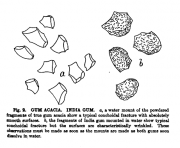Acacia senegal (gum)
(add references tag) |
|||
| Line 1: | Line 1: | ||
| − | = | + | =Nomenclature= |
| − | =Macroscopic | + | =Botanical Voucher Specimen= |
| + | =Organoleptic Characteristics= | ||
| + | =Macroscopic Descriptions= | ||
{{Macroscopy | source=United States Dispensatory (1918) | {{Macroscopy | source=United States Dispensatory (1918) | ||
| description=The most important of the gum-yielding Acacias is the official ''A. Senegal'' Willd. | | description=The most important of the gum-yielding Acacias is the official ''A. Senegal'' Willd. | ||
| Line 9: | Line 11: | ||
}} | }} | ||
| − | =Microscopic | + | =Microscopic Characteristics= |
{{Microscopy | source=Schneider, A. (1921) The Microanalysis of Powdered Vegetable Drugs, 2nd ed. | {{Microscopy | source=Schneider, A. (1921) The Microanalysis of Powdered Vegetable Drugs, 2nd ed. | ||
| mainimage=Microanalysis_powdered_vegetable_p_202_google_ver_acacia.png | | mainimage=Microanalysis_powdered_vegetable_p_202_google_ver_acacia.png | ||
| Line 21: | Line 23: | ||
| adulterants=India gum is the most common adulterant of gum acacia. Old gum acacia turns yellowish amber color and increases in brittleness. The impurities are generally negligable and should not exceed 1 per cent. | | adulterants=India gum is the most common adulterant of gum acacia. Old gum acacia turns yellowish amber color and increases in brittleness. The impurities are generally negligable and should not exceed 1 per cent. | ||
| }} | | }} | ||
| − | = | + | =High Performance Thin Layer Chromatographic Identification= |
=Other Points of Interest= | =Other Points of Interest= | ||
<references /> | <references /> | ||
Revision as of 16:23, 22 January 2014
Contents |
Nomenclature
Botanical Voucher Specimen
Organoleptic Characteristics
Macroscopic Descriptions
|
Microscopic Characteristics
|
